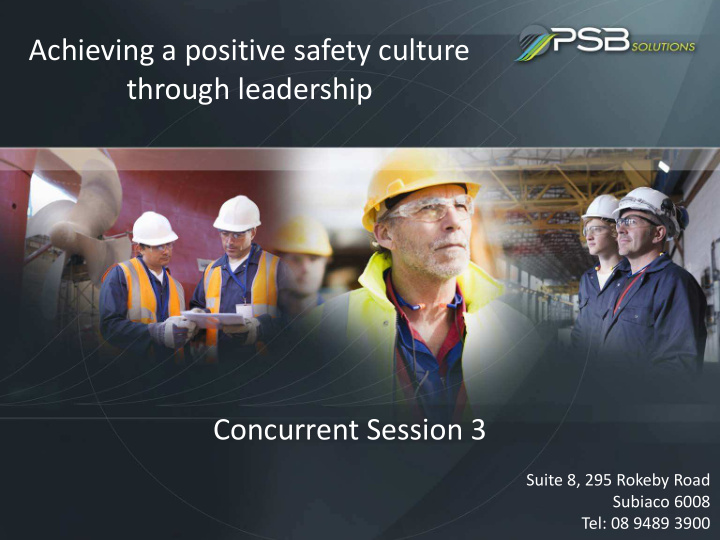



Achieving a positive safety culture through leadership Concurrent Session 3 Suite 8, 295 Rokeby Road Subiaco 6008 Tel: 08 9489 3900
Who Are We? – Marisa Mills & Meghann Croome – Industrial Psychology and Safety – Culture Change – Systems – Human Factors
What is Safety Culture?
Safety Culture The way we do things around here. - Schein, 1992
Characteristics of a Positive Safety Culture • Visible. Leadership • Accountable. • Workers will stop work if conditions are unsafe. Workforce • Everyone takes responsibility. • A culture where people are willing to report errors and near misses. Reporting Culture* • A culture of ‘no blame’ where there is an environment of trust and Just Culture* people are encouraged or rewarded for providing safety information, and there is a clear line between acceptable and unacceptable behaviour. • Shifting from a directive hierarchical model to a more flatter structure. Flexible Culture* Rewards innovation. • Sharing information, learning from past mistakes, using safety Learning Culture* performance data effectively, and implementing major reforms when required. *Reason, 1997
Culture (Schein, 1992) Artefacts What we see and have Symbols of the organisation’s identity Behaviours What we do Observable actions of personnel Espoused Values What we say we value in safety Our spoken safety values Beliefs What we believe the organisation values around safety. Deep seated and stable.
Shaping Culture – Achieving Alignment • The right beliefs We shape culture • The right words through our active • The right actions commitment • Supported by your artefacts
The Leader “Walking the Talk” Artefacts What we see and have What the leader uses Behaviours What we do What the leader does Espoused Values What we say we value in safety What the leader says Beliefs What the leader truly believes
Behaviours Active vs Passive Commitment Passive: Active: • All talk no action! • Says they are committed • Has anyone worked for a leader • Their actions reflect this like this?
Key Active Behaviours How resources are What is measured Reactions to critical allocated in tough and controlled incidents and crises times The qualities we How you engage look for when we What you mentor and recognise promote or recruit others on others people
Key Active Behaviours • One of the most effective and powerful ways that a leader has available for communicating what they believe in and demonstrating what they care about, is by what the systematically pay attention to. This ranges from anything that they: Pay Notice attention Comment to
Key Beliefs Beliefs required for event-free performance (HPI Literature): • Absolutely safe environments do not exist 1 • Human beings are fallible 2 • People want to do a good job 3 • Human error is normal 4 • There is no such thing as a ‘routine’ task or activity 5 • Significant events are organisational failures 6 • Error presents an opportunity to learn and improve organisational effectiveness 7
Summary • Alignment between values and behaviours shape beliefs in the organisation. • The leader needs to understand Human Performance Improvement Principles to help guide their behaviours.
Thank You! For Further Information contact PSB Solutions on 9489 3900. Visit our web: www.psbsolutions.com.au Email: MarisaM@psbsolutions.com.au MeghannC@psbsolutions.com.au Info@psbsolutions.coom.au Visit our office: Suite 8, 295 Rokeby Road Subiaco.
Recommend
More recommend